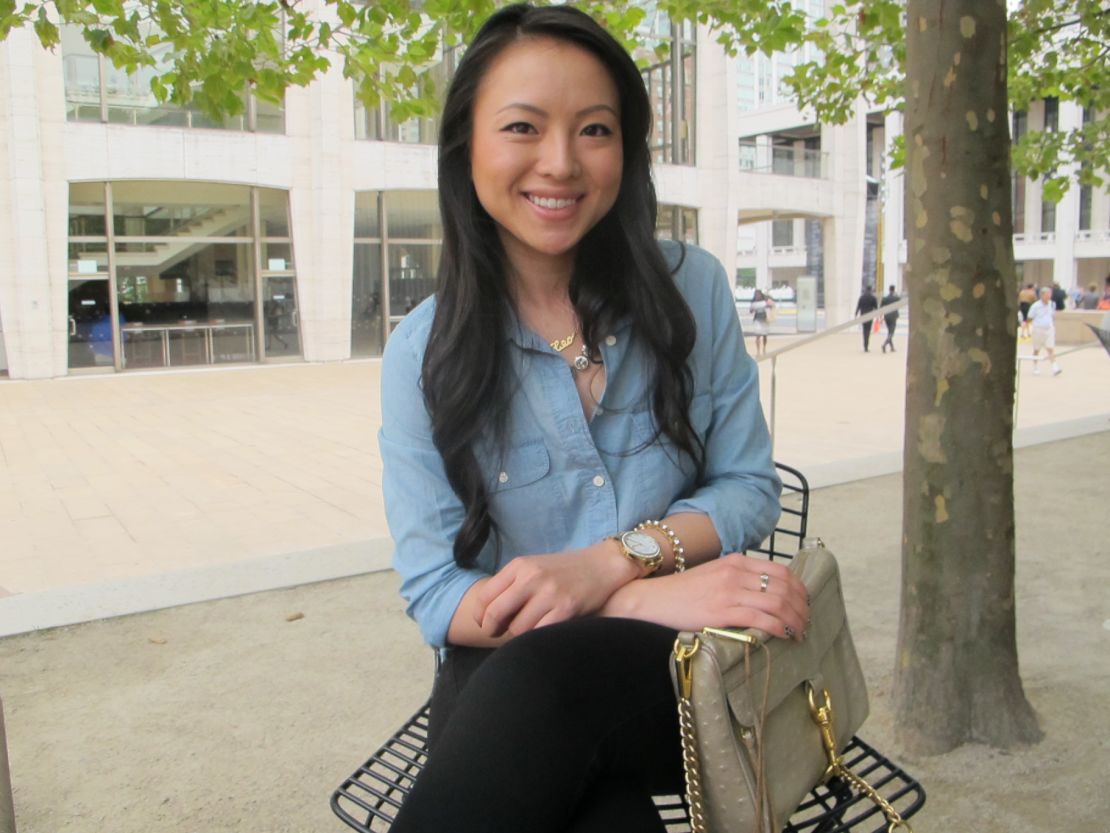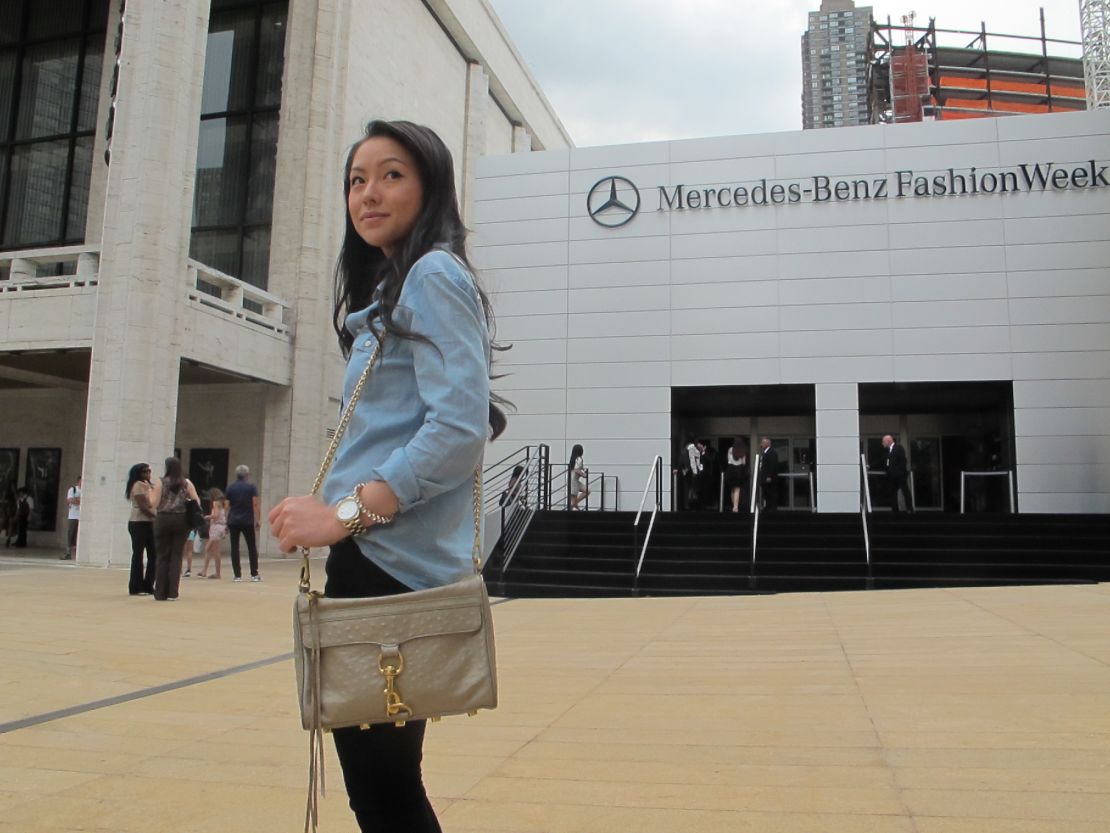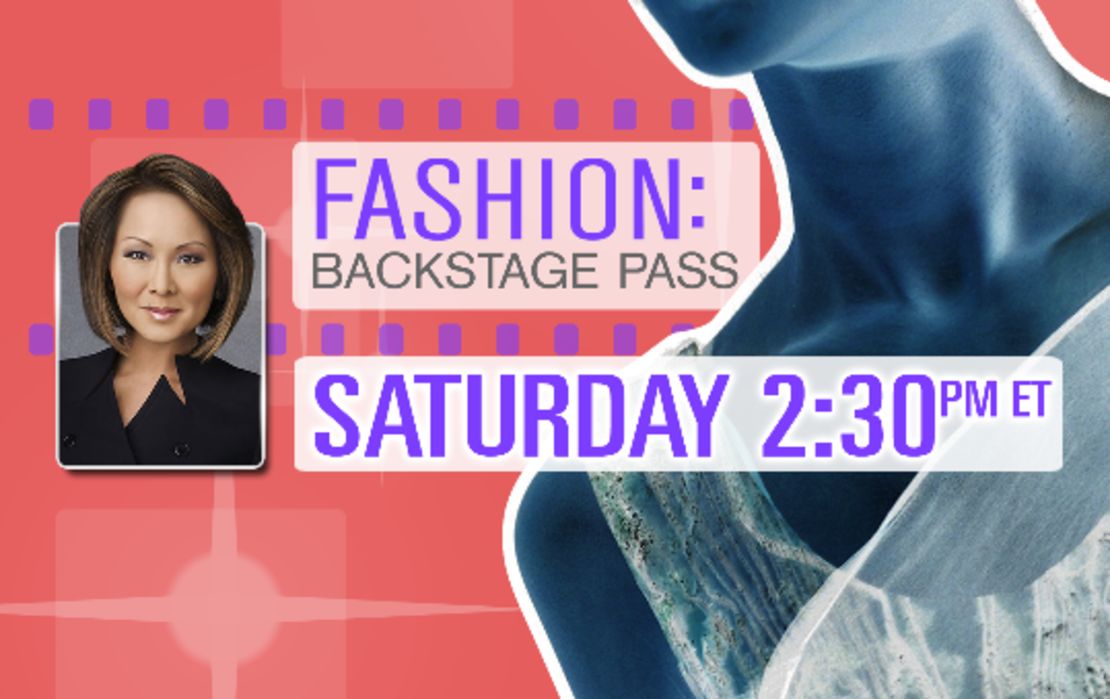Story highlights
Social media and technology are opening up exclusive Fashion Week events to consumers
Designers stream shows live on their websites and offer items for immediate pre-order
Consumer demand has sent the seasonal fashion cycle to into flux and led to new buying tools
Kate Ogata inherited a love for fashion designer Rebecca Minkoff from her mother, who taught her to search for deals on clothing so she could afford to splurge on the designer’s pricey handbags.
For years, Ogata carried around a secondhand Minkoff purse before getting her own gray “morning-after bag” with silver hardware when she was 21. She can identify the designer’s signature bag by its accents from a mile away.
Ogata never would have predicted that her designer devotion would send her to Mercedes-Benz Fashion Week in New York for Rebecca Minkoff’s 2013 spring runway show on Friday, putting the 24-year-old boutique manager in the same theater as influential fashion insiders and all manner of celebrities, from Olympians Sanya Richards-Ross and Ryan Lochte to actors Hailee Steinfeld and Kristin Chenoweth.
“It’s a once-in-a-lifetime opportunity. How often do you get to see a runway show in person?” Ogata said as she sat in Lincoln Center, the main venue for the biannual week in which brands unveil their collections for next season.

Ogata wouldn’t have made it to fashion’s holy grail this year without a little help from modern technology. Last month, Minkoff encouraged fans to Instagram images of how they “rock” the designer’s styles. Ogata responded with images of her favorite bags with the hashtag #RMCatwalk and won two tickets to the Rebecca Minkoff runway show. The prize didn’t include airfare, so with the help of her mother, Ogata scrounged up enough money to visit New York from San Francisco with her older sister for three nights so she could attend the show.
While a ticket to a live show is the big score, fashion addicts don’t need to be in New York to see trends as soon as they hit the runway. The proliferation of online fashion portals, live streaming and social media are bridging the gap between brands and consumers, making the rarefied world of high fashion more accessible than it has ever been, insiders said. And, perhaps nowhere else is this evolving trend in greater evidence than at Fashion Week.
The #NYFW diet: Part of the job?
“There used to be a kind of dictatorial relationship between the brand and the consumer,” said Uri Minkoff, CEO of Rebecca Minkoff, who is also the designer’s older brother. “The shows were for editors and buyers. Buyers would place their orders and editors would gather their thoughts and four to six months later, a product would hit the floor. So really, the consumer was in the dark and didn’t know what the trends were until they hit the floor and even then, it was this highly curated selection.
“What’s very fascinating now with social media is you have everything becoming instant,” he said. “The moment the designer or the brands shows their goods, not only do you have editors and buyers there, but through major platforms of Facebook, Twitter, Instagram and Pinterest you’re getting real time critiques. You’ve added another layer on the editorial side.”
What used to be a trade event that received very little outside attention has exploded into a cultural touchstone drawing a wide range of celebrities, bloggers and industry acolytes, along with the curious onlookers who loiter around the venues to observe and document the parade of style.

“Shows like ‘Project Runway’ and ‘Fashion Star’ have made it so that everyone feels entitled to participate in fashion” said Brandon Holley, editor-in-chief of Lucky magazine. “It has become national entertainment versus an industry must-do, must-attend event.”
Style mavens flock to Fashion’s Night Out
Sites like Style.com beam images directly from the runway; so do fashion bloggers who take pictures from the front row and instantly share the images on social media. A good portion of the New York Fashion Week runway shows are live-streamed, allowing viewers to catch the collections in real time, with brands like Rebecca Minkoff adding a social feed to their live-stream so users can see what others are saying.
“It varies from designer to designer but I think most have embraced these developments and really enjoy more direct interaction with consumer,” said Dirk Standen, editor-in-chief of Style.com. “It’s made designers globally famous in ways that perhaps they weren’t before and fashion has become a form of entertainment on par with Hollywood in many ways.
Style.com was the first site to post images from runway shows within 24 hours more than a decade ago; now, people complain if it takes more than an hour, and that level of impatience is starting to extend to the collections’ availability, Standen said. “The slow democratization of fashion is a blessing and a curse for the industry, which is trying to figure out how to feed consumer appetites on a shorter time frame than the traditional industry calendar,
“The consumer sees the look on the runway and loves it and wants it right away but obviously it’s not going to be in the store for months,” said Standen. “It’s starting to change but it’s obviously a very complicated process, logistically.”
Within that discussion is another question of whether traditional seasons apply to luxury consumers, whose offices are heated in the winter, air-conditioned in summer and who are often traveling the world, he said.
Regardless of what happens to the calendar, many believe Fashion Week still serves as the best vehicle for brands to convey an extrasensory experience of their branding.
“Even with Project Runway and Fashion Star, people still think of the fashion show as the culmination of all the work behind the scenes,” Fashionista editor-in-chief Leah Chernikoff said. “In New York and even other fashion cities, it’s such a tradition that seems so integral to the culture of the cities. I think we’ll certainly continue to see changes, but we won’t see them going away anytime soon.”
To address the growing demand for immediate gratification, some brands have experimented with selling collections off the runway or allowing consumers to preorder looks through e-commerce site Moda Operandi. The company was started in response to the fact that buyers for stores typically order only a fraction of a collection thought to be the most marketable, said Aslaug Magnusdottir, co-founder and chief executive officer of Moda Operandi. Plus, when customers preorder a dress or coat after seeing it on the runway, they put down a 50% deposit, which gets passed wholesale to designers, in a rare instance of them getting paid upfront.

“Designers are getting real consumer feedback before finalizing production decisions. It’s better than getting a Facebook “like” or a tweet because those might not necessarily translate into sales,” she said.
Moda Operandi worked with 250 brands during the last New York Fashion Week in February and plans to repeat that success this week. They’re also planning to launch an immediate delivery function in November for customers who like to shop in season instead of months ahead, in the typical retail cycle.
Some brands are experimenting with digital fashion shows, which are staged and filmed ahead of time and aired during Fashion Week, courtesy of talent and production agency KCD, which produces most of the live Fashion Week shows. The finished products, which are hosted online, also feature extra assets like stills and footage from backstage, interviews, closeups of hair, makeup and products.
“We created digital fashion shows for the industry, for retailers and editors who need to go to shows to create media and buy collections, so the brands are reaching the same audience but not forcing them to physically attend,” said Rachna Shah, Managing Director of KCD Digital. “However, this also appeases the consumer appetite.”
KCD Digital launched the product at last season’s shows in February and produced three more to debut this New York Fashion Week: See by Chloe, which was taped in Paris, ICB, filmed in Brooklyn, and Pierre Balmain from Beijing.
Digital fashion shows aren’t meant to replace traditional runway shows but simply to provide an alternative for brands that might not get the same audience or attention if they tried to show their lines live, Shah said. Much like the presentation format, in which designers stage their models instead of having them walk, digital fashion shows can save time and money for a fledgling brand, or even one simply looking for flexibility.
Customization and engagement are becoming increasingly high priorities for start-ups hoping to break onto the scene. One example is Stylyt, a collaborative commerce platform that lets consumers play fashion designer. Contemporary brands showcase fabrics, colors and shapes from their collections and let users create their own branded product. The Stylyt community then votes, and the brands manufacture winning designs to be sold exclusively on Stylyt.
“Social media has fundamentally changed the way people shop and discover fashion. Consumers have greater access to brands and expect open, authentic dialogue,” said co-founder Nina Cherny. “We’re taking these conversations beyond Facebook and Twitter by giving consumers a visual and tangible way to feel involved. Letting consumers play fashion designer for their favorite brands not only gives consumers a real voice, but also provides brands with a visual, interactive and predictive way to find out what consumers want to buy before anything hits stores.”
High fashion, minus the labels
The project is gearing up for public launch this fall with an eye toward collaborations with brands like Timo Weiland.
Despite all these technological innovations, the biggest game-changer for how brands interact with fans is still via relatively old-fashioned social media, especially for older brands trying to reach new audiences, Chernikoff said. Maybe they can’t afford the high-end items they covet now, but hopefully one day they will.
“Part of the idea of luxury is being out of reach and aspirational,” she said. “For them, the difficulty of straddling social media is to make yourself accessible to new customers, but you don’t want reveal too much. Those designers are figuring out what works for them and how to strike that balance.”
Others, like Rebecca Minkoff, have gone full steam ahead since they started out. Not long after launching in 2005, Minkoff noticed that users on the Purse Forum blog were talking about her products and what worked. So Minkoff jumped in and joined discussions about problems with certain styles,usinge feedback to guide refinements and modifications of components like pockets, buckles and hardware, Uri Minkoff said.
Since then, the brand has aimed to be ahead of the curve with each new social media tool. Its Facebook page, which has more than 86,000 fans, has been a good vehicle for the brand to stream shows and seek large-scale feedback, Uri Minkoff said. Twitter has been great for short update, mobilizing contests and scavenger hunts among the brand’s 66,000 followers. The brand’s Instagram following currently earns them about 500 to 800 new followers day, with photos on average earning 1,800 to 1,900 likes per image.
Though Kate Ogata follows Rebecca Minkoff on all platforms, Instagram is by far her favorite, she said. A blogger herself, Ogata appreciated the voice and personality Minkoff brings to her social media presence and takes cues from Minkoff’s sources of inspiration.
“She inspires me to try new things but to be true to myself,” she said. “You see her as a real person and not just a label in a bag.”
Do you use social media to connect with your favorite designers or purchase exclusive fashion collections? Share your experiences in the comments section below.
Designer on the rise: Mohapatra’s moment






















